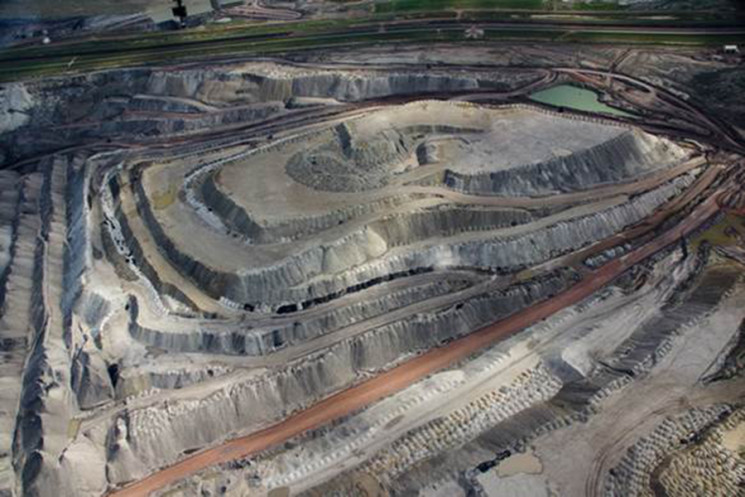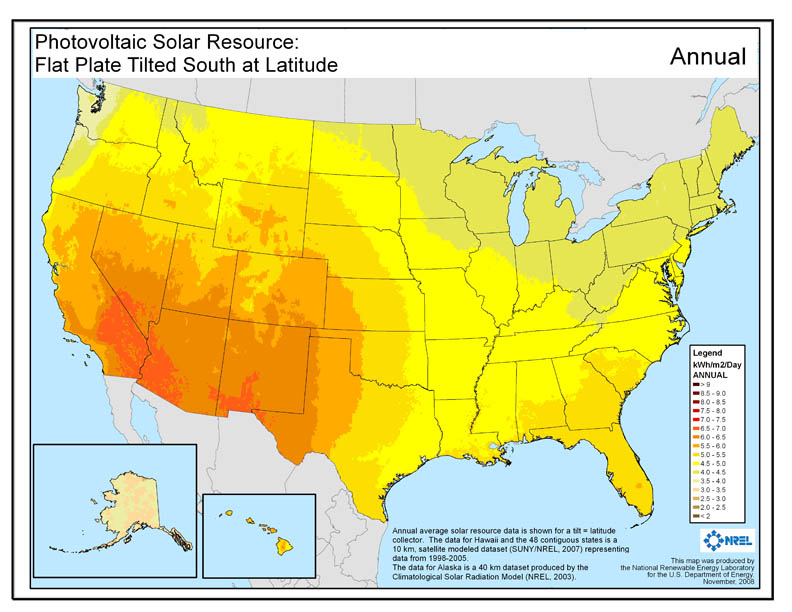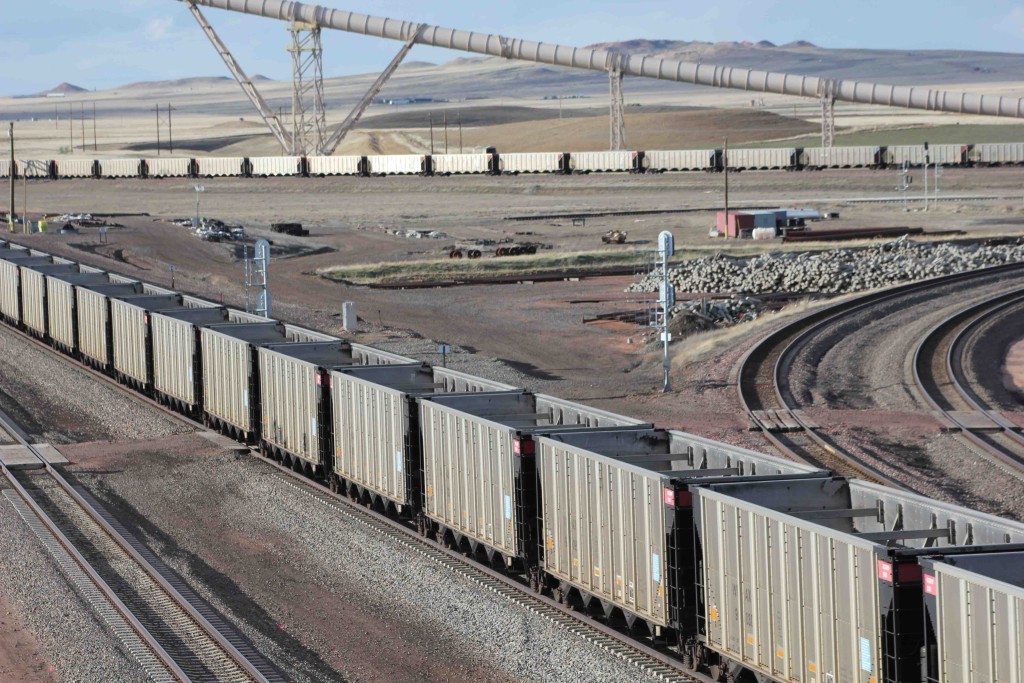Wyoming, the epicenter of U.S. fossil fuel extraction, is hemorrhaging jobs, the New York Times reported today:
Tumbling prices for oil and gas, along with bankruptcies in the coal industry, have pummeled Wyoming’s energy-dependent economy and eroded a thin safety net for poor and older residents. Energy development helped Wyoming weather the nation’s thin years seven or eight years ago, but now officials estimate that energy companies have shed some 5,500 jobs — a huge number in a state with 580,000 residents.

Black Thunder coal mine in Wyoming’s Powder River Basin. Its owner filed for bankruptcy in January.
The coal bust is stark. U.S. coal-fired electricity plants produced nearly 15 percent fewer kilowatt-hours last year, which is down almost a third from their 2007 peak. Total coal mining fell 10 percent, to a 30-year low, and while 2015 state coal extraction data aren’t available, Wyoming, the source of 40 percent of U.S. coal output, of which almost all is exported over huge distances by train or “by wire,” surely took a huge hit. And though production of “hydrocarbons” (oil and gas) is up nationwide, much of the action is now in fracking regions like North Dakota and Pennsylvania; moreover, drilling of new wells has plummeted along with prices.
As the Times reports, the job losses are exacerbated by parochial decisions by the Republican-dominated state government including a refusal to expand Medicaid under President Obama’s health care law. “A literacy program that helped people get high-school equivalency degrees was eliminated,” added the Times, “as were programs that provided dental care and property-tax rebates to low-income old people.”

The author in Wyoming’s Big Horn Range, 1977. Photo: Howard Shaw.
This is painful to read on many levels, which for me include indelible memories of good times in Wyoming and Montana in the mid- and late seventies. As I wrote, years later:
Defending the American West from ruinous energy development was a particularly intense, gut-level part of that struggle for many of us, including me. I was living in New York then but spending as much time as I could in the Northern Rockies, hiking the high country and getting out onto the land, meeting ranchers, Indians, environmentalists and fellow eco-freaks. I fished for my breakfast in Shoshone streams, played barrelhouse piano in a Montana renewable-energy road show, and got high inhaling Amory Lovins’ Soft Energy Paths at 12,000 feet in the Wind River range.
The irony is that the energy technologies we insisted could take the place of environmentally and economically ruinous fossil fuel exploitation have finally arrived . . . and Wyoming is perfectly positioned to take advantage. The state ranks #8 out of all 50 in wind energy potential, behind only Texas, Montana, Nebraska, Kansas, Iowa and the Dakotas, according to estimates by the National Renewable Energy Laboratory.
The NREL data further suggest that developing only the windiest areas in the state — where 80 meter-tall turbines could achieve 30% annual capacity factors — could generate more than 1.9 trillion kWh a year, or triple the electricity now generated from the state’s entire annual coal output. Yet actual Wyoming wind production is around a thousand times less. (See calculations below; note that NREL’s wind potential excludes a quarter of the state’s windy lands that are protected, developed or otherwise inappropriate, and draws on 2010 assumptions that predate recent new productivity from larger turbines and more sophisticated controls.) Yes, unlocking that potential requires big investments in transmission, but the hellish processions of massive unit trains bearing Wyoming coal to the Midwest and South could diminish and cease.

NREL, 2008. For the geographically challenged, Wyoming is the rectangle between Colorado and Montana.
Wyoming looks well positioned for solar as well. The map at left suggests that the Equality State (yep, that’s its motto) is in the top ten, behind California, Nevada, Texas, the Four Corner states, and perhaps Nebraska and Oklahoma. Actual solar electricity generation in Wyoming is nil, however.
Many forces have stopped extensive wind and solar development. Some, like the nation’s only wind production tax, are state-specific; others, like the absence of a carbon price, are more generic. Both of these reflect and reinforce the political power of the fossil fuel industry along with cultural and cognitive biases that valorize carbon fuels at the expense of sustainable energy.
Only time will tell whether the latest downturn in Wyoming’s cycles of boom and bust will lead to a change of heart and in public policy and enable the jobs disappearing from the extractive industries to be replaced by jobs in renewables. For now, this state of rugged but empty landscapes is about to get even lonelier.

Unit trains await loading at Black Thunder. 120 cars carry 120 tons each.
Calculations for paragraph preceding solar map: Wyoming coal mines produced just under 400 million tons in 2014. Applying standard factors of 8,500 btu/lb for Powder River Basin coal and 1 kWh generated per 10,000 btu released in combustion, that tonnage would have generated 680 billion kWh. The 2015 figure is almost certainly less, and probably under a third of the 1,944 billion kWh annual Wyoming wind potential estimated by NREL using 2010 technology assumptions.

Bruce Burdick says
Great article
Who will invest in wind and solar in Wyoming?
Neil Heesterman says
If a global carbon tax would be agreed upon the coal industry could be saved. If, like in Norway, companies are paid for every tonne of CO2 they capture and store, many coal fired plants could be made clean and competitive. I live in British Columbia, Canada. If the whole world would accept our carbon tax rate the cost of thermal coal would go up by at least 70%. Since the cost of electricity from coal fired power plants includes 45% for fuel, that 70% increase would eliminate the 4c/KWh competition, which we presently face to sell our 8.5c/KWh wind power. The captured carbon no longer has to be stored deep underground and used for enhanced oil recovery. It has been proven that it can be converted to fuel, plastics, fertiliser and cement. That production could also be encouraged by a global carbon tax.
Yesterday I gave a comment on an excellent article about Bernie Sanders stand on carbon tax during the debate with Hillary Clinton. I have been following carbon pricing since early 2013. That is when the Gower company published a new 316-page book on economics. The title is “Rediscovering Sustainability”. It contains some interesting facts about carbon pricing. It is written by my brother and sister in-law and I started searching how it affects Canada and our prospects to make pipelines more acceptable. In October 2013 I started a blog, “pipelines and carbon tax” to record my findings. It can be accessed via http://www.neilwilhees.blogspot.ca I kept searching the web for interesting facts, not covered by the main media. I also learned about how much humans have contributed to climate change and my 26 post blog contains many resulting facts not covered by the main media. I can back up all my statements and most of them are hyperlinked to source documents. While Mrs. Clinton believes that Mr. Sanders can’t convince people to accept a carbon tax, I am not so sure. During and following the Paris conference the main media finally started paying more attention on what the problems and solutions are. I hope that Mr. Sanders will convince many and win the election.
Rob Benjamin says
The basic flaw in the “clean coal” argument is that it focuses entirely on only one part of the coal life cycle – combustion. I will stipulate that coal combustion can be, if not clean, then at least a lot cleaner than it currently is. But all of processes that PRECEDE and FOLLOW combustion are much harder to clean up. And the predecessor processes are probably impossible to clean up without a net energy cost that comes close to, and probably exceeds the net energy value of clean coal combustion.
Mountaintop mining with all of its associated toxic runoff impacts, and unsafe storage costs is just the first of those predecessor processes. Getting to the furnace also entails refining costs and transport costs, all of which have their own emissions and net energy impacts. In short, the case for coal continues to decline. Wyoming and other coal producing regions can do much better and should stop wasting time and energy trying to save a fuel source that long ago outlived its usefulness.